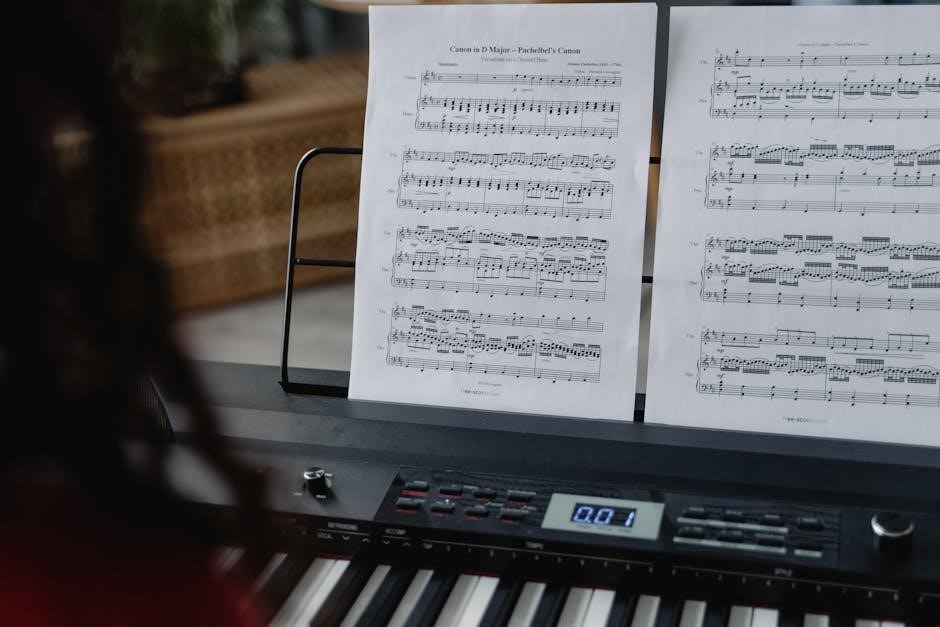Piano chords sheet music PDFs provide a comprehensive guide to mastering chord progressions‚ triads‚ and inversions․ Essential for pianists of all levels‚ these resources include keyboard diagrams and fingerings‚ offering portability and digital access for easy practice and performance․
What Are Piano Chords?
Piano chords are groups of musical notes played simultaneously‚ creating harmonic sounds․ They form the foundation of music‚ enabling pianists to accompany melodies‚ compose songs‚ and create complex harmonies․ Basic chords include triads (root‚ third‚ fifth)‚ while extended chords like seventh‚ ninth‚ and altered chords add depth․ Chords can be played in root position or inversions‚ offering versatility in music composition․ Understanding chord structures is essential for pianists‚ as it allows for smooth transitions and dynamic performances․ Chord charts and sheet music PDFs provide visual guides‚ making it easier to learn and master these musical building blocks for both beginners and advanced players․
Why Use Sheet Music PDFs?
Sheet music PDFs offer unparalleled convenience and accessibility for pianists․ They provide portable‚ high-quality resources that can be easily downloaded and accessed on various devices․ PDFs are cost-effective‚ often available for free or at a low cost‚ making them an affordable option for musicians․ They also offer the flexibility of being printable or viewed digitally‚ catering to both traditional and modern preferences․ Clear keyboard diagrams and fingerings in PDFs aid in understanding chord structures and proper techniques․ This format ensures that pianists can practice and perform with ease‚ making sheet music PDFs an indispensable tool for learning and mastering piano chords․
Structure of the Article

Understanding the Layout of Piano Chords Sheet Music PDF
The layout includes clear keyboard diagrams‚ fingerings‚ and inversions․ It is organized with chord charts and progressions‚ making it easy for pianists to learn and practice effectively․
Overview of the Layout
The layout of piano chords sheet music PDFs is designed for clarity and ease of use․ It typically features keyboard diagrams that visually represent each chord‚ making it simple to identify the correct keys to press․ Chords are organized by type‚ such as major‚ minor‚ seventh‚ and extended chords‚ with clear labels and fingerings provided․ The PDFs often include inversions and progressions‚ allowing pianists to understand how chords relate to each other harmonically․ This structured approach ensures that both beginners and advanced players can quickly locate and learn the chords they need‚ making practice and performance more efficient and enjoyable․
Organization of Chords
Piano chords in sheet music PDFs are meticulously organized to facilitate easy learning and reference․ Chords are typically categorized by type‚ such as major‚ minor‚ seventh‚ and extended chords‚ with clear labels for quick identification․ Many PDFs also include variations like suspended and diminished chords‚ providing a comprehensive harmonic palette․ Chords are often listed alphabetically or by chromatic order‚ allowing users to locate specific chords effortlessly․ This systematic arrangement ensures that pianists can access the desired chords without confusion‚ making practice sessions more productive and enjoyable․ The clear categorization also helps in understanding chord relationships and progressions‚ enhancing overall musical understanding and application․

Importance of Keyboard Diagrams
Keyboard diagrams in piano chords sheet music PDFs are invaluable for visual learners‚ providing a clear‚ concise representation of chord structures․ These diagrams depict the piano keys involved in each chord‚ making it easier to identify and play the correct notes․ They are particularly beneficial for beginners‚ as they simplify the process of learning complex chord shapes and finger placements․ Additionally‚ diagrams often include color-coded markings or labels to distinguish between root notes‚ thirds‚ fifths‚ and other components‚ enhancing understanding․ This visual aid ensures accuracy and reduces the likelihood of errors‚ making practice sessions more efficient and effective for pianists of all skill levels․
Fingerings and Inversions Explained
Fingerings in piano chords sheet music PDFs guide pianists on which fingers to use for each note‚ ensuring proper technique and minimizing strain․ Inversions‚ meanwhile‚ refer to the rearrangement of chord notes‚ offering harmonic variety and smoother transitions between chords․ By mastering inversions‚ pianists can create richer‚ more dynamic music․ These resources often provide multiple inversion options for each chord‚ allowing players to explore different voicings and adapt to various musical styles․ Clear fingering suggestions and inversion charts enable pianists to develop a deeper understanding of chord structures and enhance their overall performance quality‚ making practice more effective and enjoyable․ This detailed guidance is essential for both beginners and advanced players aiming to refine their skills and expand their musical repertoire․

Benefits of Using Piano Chords Sheet Music PDF
Piano chords sheet music PDFs offer unmatched convenience‚ portability‚ and accessibility․ They provide versatile learning tools‚ catering to all skill levels and musical genres‚ enhancing practice and performance flexibility․

Portability and Accessibility
Piano chords sheet music PDFs are highly portable‚ allowing pianists to access their music anywhere‚ anytime․ Whether practicing at home‚ in a studio‚ or during travel‚ PDFs provide unmatched convenience․ They eliminate the need for bulky sheet music collections‚ making it easy to carry an entire library on a tablet or smartphone․ Additionally‚ digital formats ensure accessibility for musicians with varying needs‚ as they can be easily enlarged or adjusted for readability․ This portability and accessibility make PDFs an indispensable tool for both aspiring and professional pianists‚ facilitating seamless learning and performance across diverse settings․ Their versatility enhances the overall musical experience․
Cost-Effective Solution
Piano chords sheet music PDFs offer a cost-effective solution for musicians‚ as they are often free or low-cost‚ providing instant access to a vast library of chords and progressions․ Unlike traditional sheet music‚ which can be expensive and limited‚ PDFs allow unlimited printing and sharing‚ making them a budget-friendly option for learners and professionals alike․ Many websites provide free downloadable PDFs‚ covering everything from basic triads to complex jazz chords․ This affordability ensures that musicians can explore a wide range of musical genres without financial strain‚ making PDFs a practical and economical choice for mastering piano chords and enhancing musical skills․
Printable and Digital Formats
Piano chords sheet music PDFs are versatile‚ offering both printable and digital formats․ This dual functionality allows pianists to use them in various settings—whether practicing on a physical piano or accessing chords digitally․ Printable PDFs can be easily laminated or placed in binders for quick reference‚ while digital versions enable on-the-go access via tablets or smartphones․ This flexibility ensures that musicians can access chord charts anywhere‚ making practice sessions efficient and convenient․ The availability of both formats caters to different learning preferences‚ providing a seamless transition between physical and digital practice‚ and enhancing overall musical productivity and accessibility for all pianists․

How to Read Piano Chord Sheet Music
Mastering piano chord sheet music involves understanding notes‚ clefs‚ and staffs․ Chord symbols indicate harmonies‚ while keyboard diagrams show key presses․ Inversions and progressions are visually explained‚ simplifying learning and performance․
Basics of Music Notation
Understanding music notation is fundamental for reading piano chord sheet music․ The staff consists of five lines and four spaces‚ each representing specific notes․ Clefs‚ such as the treble and bass clef‚ indicate pitch range․ Notes vary in shape and duration‚ with whole‚ half‚ quarter‚ and eighth notes guiding rhythm․ Rests signify silence‚ while sharps‚ flats‚ and naturals modify pitch․ Key signatures display accidentals for the piece‚ and time signatures dictate the rhythmic structure․ Bar lines divide the staff into measures‚ helping organize the music․ Familiarity with these elements is crucial for interpreting chord symbols and playing accurately․ Proper notation reading enhances musical expression and technique․
Understanding Chord Symbols
Chord symbols are abbreviations that represent chords in sheet music‚ typically consisting of a root note and modifiers like majors‚ minors‚ or sevenths․ These symbols guide pianists on which keys to press‚ ensuring proper harmonization․ They are essential for both playing and composing‚ as they convey the harmonic structure of a piece․ Chord symbols can also indicate extended chords‚ like ninth or eleventh chords‚ adding complexity to music․ By mastering these symbols‚ pianists can interpret sheet music accurately and create rich‚ emotionally resonant performances․ Resources like chord charts and PDFs provide clear visuals‚ helping musicians grasp these symbols and their applications in various musical contexts effectively․
Interpreting Inversions
Inversions in piano chords refer to the rearrangement of a chord’s notes‚ altering the lowest-sounding pitch․ A chord can be in root position‚ first inversion‚ or second inversion‚ each changing the harmonic emphasis․ Inversions are crucial for smooth chord progressions and voice leading‚ allowing pianists to create seamless transitions between chords․ Chord charts and PDFs often include inversion diagrams‚ showing each variation clearly․ Mastering inversions enhances musical versatility and enables pianists to adapt chords to different musical contexts․ Understanding inversions is essential for advanced techniques like jazz harmonies and complex arrangements‚ making them a vital part of a pianist’s skill set for dynamic and expressive performances․
Chord Progressions Made Simple
Chord progressions are the backbone of music‚ guiding harmonic movement and emotional expression․ Piano chords sheet music PDFs simplify learning by providing clear‚ visual representations of chord sequences․ Common progressions like I-IV-V are foundational‚ while more complex patterns expand creative possibilities․ These resources often include diagrams and fingerings‚ making it easier to transition smoothly between chords․ By mastering basic progressions‚ pianists can improvisation and compose with confidence․ PDF guides also offer practical exercises and examples‚ helping musicians of all levels to build a strong harmonic foundation and explore diverse musical styles effectively․ This makes learning and applying chord progressions accessible and straightforward for everyone․

Step-by-Step Guide to Using Piano Chords PDF
Mastering piano chords is simplified with PDF guides‚ offering clear keyboard diagrams‚ fingerings‚ and progressions․ These resources help pianists of all levels transition smoothly and confidently between chords․
Finding the Right Chords
Finding the right chords is made easy with comprehensive piano chord charts in PDF format․ These charts organize chords by type‚ key‚ and complexity‚ allowing you to quickly locate the chords you need․ Major‚ minor‚ seventh‚ and extended chords are clearly displayed‚ often with keyboard diagrams and fingerings to guide you․ Many resources also include chord progressions and inversions‚ helping you transition smoothly between chords․ Whether you’re playing in a specific key or exploring complex harmonies‚ these charts provide a quick reference․ Printable PDFs ensure you can practice anywhere‚ making learning and performance more accessible and efficient for pianists of all skill levels․
Practicing Chord Transitions
Practicing chord transitions is essential for smooth performances․ Piano chord PDFs provide clear diagrams and fingerings to help master transitions․ Start by practicing hands separately‚ focusing on common chords like C‚ F‚ and G․ Use a metronome to improve timing and ensure smooth shifts between chords․ Gradually incorporate inversions to enhance fluidity․ Begin with simple progressions‚ such as I-IV-I-V-I‚ and slowly increase complexity․ Set specific practice goals‚ like mastering three new transitions weekly․ Track your progress to stay motivated․ Consistent practice with these resources ensures efficient learning and seamless chord changes‚ elevating your overall playing and arranging skills․
Applying Chords to Songs
Applying chords to songs is a fundamental skill enhanced by piano chord PDFs․ These resources provide clear chord diagrams and fingerings‚ making it easier to accompany melodies or create harmonious backing․ Start by identifying the key of the song and selecting relevant chords from the PDF․ Practice playing chord progressions smoothly‚ using inversions to maintain flow․ Experiment with adding seventh chords or extensions for depth․ Use the keyboard diagrams to visualize note placements and ensure accurate finger placement․ Portable and accessible‚ these PDFs allow you to reference chords anytime‚ helping you apply them confidently to various songs and genres‚ from pop to jazz․
Using Tools and Apps
Enhance your learning with tools and apps that complement piano chord PDFs․ Interactive chord charts and apps like Chordify or Piano Nanny offer real-time chord generation and playback․ These tools allow you to experiment with chord progressions‚ visualize fingerings‚ and practice along with metronomes․ Many apps provide searchable databases of chords‚ enabling quick reference during practice․ Additionally‚ platforms like ToneGym offer sight-reading exercises to improve your skills․ Portable PDFs can be imported into apps for digital annotation‚ making them versatile for both digital and print use․ These resources are ideal for pianists seeking to streamline their practice routines and deepen their understanding of chord applications in various musical contexts․

Top Resources for Piano Chords Sheet Music PDF
Discover top resources offering free and premium piano chord PDFs‚ including comprehensive guides from websites like ChordsLOL and Piano Lessons Info‚ featuring triads‚ seventh chords‚ and extended harmonic options․
Free Websites for Download
Several websites offer free piano chord sheet music PDFs for download‚ making it easy to access essential resources․ Websites like ChordsLOL and Piano Lessons Info provide comprehensive chord charts‚ including triads‚ seventh chords‚ and extended harmonies․ These PDFs often feature clear keyboard diagrams‚ fingerings‚ and inversions‚ catering to both beginners and advanced players․ Additionally‚ platforms like Musicnotes and Sheet Music Plus offer free and premium piano chord PDFs‚ ideal for learning and performance․ Many sites also include interactive tools and chord progressions‚ allowing users to practice and apply chords effectively․ These resources are perfect for pianists seeking versatile and accessible learning materials․
Popular Online Libraries
Popular online libraries like Virtual Sheet Music and ToneGym offer extensive collections of piano chords sheet music PDFs․ These platforms provide high-quality‚ downloadable resources‚ catering to pianists of all skill levels․ Virtual Sheet Music features a wide range of genres‚ from classical to modern‚ while ToneGym focuses on interactive tools for learning․ Both libraries ensure access to comprehensive chord charts‚ including triads‚ seventh chords‚ and extended harmonies․ They also offer printable formats‚ making it easy to practice and perform․ These libraries are essential for pianists seeking versatile and high-quality sheet music to enhance their learning and playing experiences․
Creating Your Own PDFs
Creating your own piano chords sheet music PDFs allows for customization and specificity․ Tools like Piano Nanny or Chordify enable users to generate chord charts tailored to their needs․ Whether for learning‚ teaching‚ or performance‚ custom PDFs ensure relevance and focus․ Many websites provide templates or software for designing chord sheets‚ which can then be saved as PDFs․ This flexibility is particularly useful for musicians who need chord progressions for specific songs or genres․ By creating your own PDFs‚ you can organize chords‚ include fingerings‚ and even add musical notation‚ making practice and performance more efficient․ This approach is ideal for both beginners and advanced pianists seeking personalized resources․

Advanced Techniques with Piano Chords PDF
Explore extended chords‚ altered chords‚ and jazz harmonies to significantly enhance your musical depth․ Master complex voicings and advanced inversions for sophisticated arrangements and performances․
Extended and Altered Chords
Extended and altered chords add depth and complexity to your music․ These include 9th‚ 11th‚ and 13th chords‚ which expand harmonic possibilities․ Altered chords‚ such as flat 5th or sharp 5th‚ introduce dissonance and tension․ PDF resources provide clear diagrams and fingerings for these advanced chords‚ making them accessible to pianists․ Jazz and contemporary music often utilize these chords to create rich‚ intricate soundscapes․ Mastering extended and altered chords opens up new dimensions in composition and performance‚ allowing for greater emotional expression and musical sophistication․ Regular practice with these chords will elevate your playing to a professional level‚ enhancing your artistic versatility․
Jazz and Complex Harmonies
Jazz and complex harmonies rely heavily on extended and altered chords‚ creating rich‚ layered soundscapes․ Piano chords sheet music PDFs often include detailed diagrams for jazz voicings‚ 9th chords‚ and modal interchange․ These resources are invaluable for pianists aiming to master improvisation and intricate progressions․ Whether exploring bebop or modern jazz‚ PDF guides provide clear fingerings and inversions for advanced chords․ Practice with these materials helps pianists navigate complex harmonies seamlessly‚ enhancing their ability to play jazz standards like “Body and Soul” or “Blue Bossa․” Mastering these techniques elevates musicality‚ allowing for sophisticated interpretations and original compositions․
Advanced Inversions and Voicings
Advanced inversions and voicings expand the musical palette‚ offering pianists nuanced ways to play chords․ Sheet music PDFs often detail rootless voicings‚ drop voicings‚ and shell voicings‚ which are essential in jazz and contemporary music․ These techniques allow for smoother transitions and richer harmonies․ By learning first‚ second‚ and third inversions‚ pianists can create varied harmonic textures․ PDF guides provide clear diagrams and fingerings‚ helping pianists master these advanced voicings․ This knowledge enhances versatility‚ enabling pianists to adapt chords to different musical styles and arrangements․ Practicing these techniques deepens musical expression and opens up new possibilities for improvisation and composition․

Practice and Application Tips
Set specific practice goals‚ track progress‚ and stay motivated․ Use tools and apps to enhance learning․ Apply chords to songs and experiment with transitions for a polished sound․
Setting Practice Goals
Setting clear practice goals is essential for mastering piano chords․ Start with achievable objectives‚ such as learning a specific chord or progression weekly․ Allocate 15-30 minutes daily for focused practice․ Use piano chords sheet music PDFs to guide your sessions‚ ensuring you cover triads‚ seventh chords‚ and inversions systematically․ Prioritize proper fingerings and technique to build a strong foundation․ Incorporate metronome exercises to improve timing and smooth transitions․ Track your progress by revisiting challenging chords and gradually increasing complexity․ Regular review and goal adjustment will help maintain motivation and ensure steady improvement in your piano chord mastery․
Tracking Your Progress
Tracking your progress when learning piano chords is crucial for consistent improvement․ Use a practice journal to document the chords and songs you master․ Regularly revisit challenging chords to assess improvement․ Record your playing to identify areas needing refinement․ Utilize apps or tools to monitor consistency and accuracy․ Set milestones‚ such as mastering a set of chords or performing a song‚ to celebrate achievements․ Periodically review your piano chords sheet music PDF to ensure you’re covering all necessary techniques․ Tracking progress helps you stay motivated and focused‚ ensuring steady growth in your piano chord mastery and overall musical skills․
Staying Motivated
Staying motivated while learning piano chords is essential for consistent progress․ Celebrate small milestones‚ like mastering a difficult chord or playing a favorite song smoothly․ Set achievable goals and reward yourself for reaching them․ Surround yourself with music that inspires you‚ and explore various genres to keep your practice engaging․ Use apps or tools to make learning interactive and fun․ Join online communities or find a practice buddy for support and encouragement․ Remember‚ progress takes time‚ and every effort brings you closer to your musical goals․ Stay inspired‚ and let the joy of playing piano chords keep you motivated and excited to learn․
Piano chords sheet music PDFs are an essential resource for pianists‚ offering comprehensive guides and versatility․ They aid in learning and mastering chords effectively for all skill levels․
Recap of Key Points
Piano chords sheet music PDFs are a comprehensive resource for pianists‚ offering detailed chord charts‚ diagrams‚ and fingerings․ They cover triads‚ seventh chords‚ inversions‚ and extensions‚ providing a foundation for various musical styles․ These PDFs are portable and accessible‚ suitable for both digital and printed use․ They cater to all skill levels‚ from beginners learning basic chords to advanced players exploring complex harmonies․ The inclusion of keyboard diagrams and fingerings aids in proper technique and quick reference․ Additionally‚ they emphasize understanding chord progressions and inversions‚ making them invaluable for practice‚ composition‚ and performance․ Tools and apps complement these resources‚ enhancing learning and application․
Encouragement for Continued Learning
Embrace the journey of mastering piano chords with dedication and curiosity․ Consistent practice will unlock new musical possibilities‚ fostering creativity and confidence․ Explore diverse genres‚ from classical to jazz‚ using chord charts as your guide․ Utilize free PDF resources and interactive tools to enhance your learning․ Stay motivated by setting achievable goals and celebrating progress․ Engage with online communities and seek inspiration from pianists worldwide․ Remember‚ learning is lifelong‚ and each chord mastered brings you closer to musical excellence․ Keep experimenting‚ composing‚ and enjoying the piano’s expressive power․ With persistence‚ you’ll continue to grow as a musician‚ making meaningful music for years to come․
Additional Resources
Supplement your learning with a variety of resources available online․ Websites like ChordsLOL and ToneGym offer free piano chord charts‚ interactive tools‚ and comprehensive guides․ Explore platforms such as Piano Lessons Info for downloadable PDFs and detailed chord formulas․ Additionally‚ communities like Sheet Music Plus provide extensive libraries of sheet music and chord diagrams․ Utilize these resources to deepen your understanding of piano chords and enhance your practice․ Whether you’re a beginner or an advanced player‚ these tools will help you master chord progressions‚ inversions‚ and complex harmonies‚ ensuring a well-rounded musical education and continuous improvement in your piano journey․
